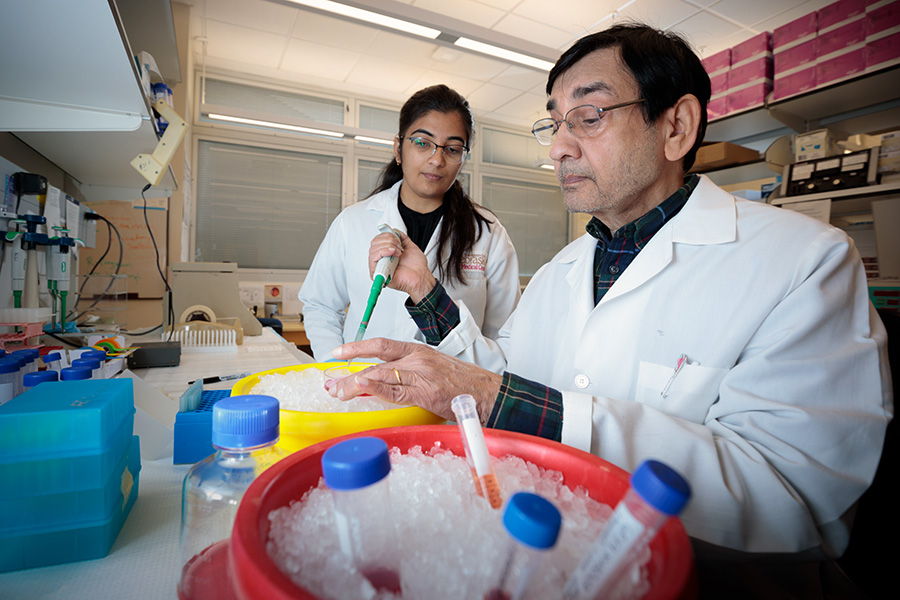Singh Lab
Molecular and Cellular Biology Lab

Unveiling causes and mechanisms of age-related diseases and therapeutic interventions
The general interests of Singh's lab include the causes and molecular mechanism(s) responsible for cell survival, ways in which these survival processes go awry in various diseases, and identification of the downstream deleterious cellular signaling involved in initiation and progression of aging and age-related degenerative disorders, with the goal of developing mechanism-based therapy. The eye lens and cataractogenesis are used as a model system for aging diseases because of their unique and simple structure and metabolic features. Investigators at the laboratory make extensive use of state-of art modern techniques and biochemical analysis applicable to the research projects. Much of the research is based on the hypothesis that, as lens epithelial cells (LECs) survive throughout life, such cells may contain a survival molecule. Through studying the mechanism and regulation of cell survival, the research team have discovered three molecules: i) Lens Epithelium-Derived Growth Factor (LEDGF), which acts as a transcription factor; ii) lenticular Peroxiredoxin 6 (Prdx6), a multifunctional protective protein, and iii) Lens Epithelium-Derived Protein (LEDP), which maintains endoplasmic reticulum-Golgi homeostasis and blocks LEC death from unfolded protein response and endoplasmic reticulum (ER) stress inducers.
Research has been devoted to characterizing LEDGF, Prdx6 and LEDP; determining how these molecules are regulated during aging, and identifying ways in which their expression and functions are crucial for cell survival and cell homeostasis. The lab’s research has anticipated many major trends and contributed substantially to knowledge in several areas: i) the molecular mechanisms of pathological signaling involved in etiopathogenesis of age-related disorders, particularly blinding diseases; ii) the role and characterization of oxidative stress induced by external and physiological factors in disrupting cell homeostasis; iii) application of the moonlighting protein Prdx6 to sick cells, and enhancing Prdx6 transcription by means of naturally occurring compounds to postpone pathogenic signaling that causes disease; and iv) identification of LEDGF and LEDP expression level as crucial to maintenance of cell physiology. (Aberrant expression of these molecules lead to etiopathogenesis, while physiological levels maintain cell homeostasis.)
The lab’s forward-looking efforts have provided insight into basic molecular mechanisms of initiation and progression of age-related cataract, glaucoma and other degenerative disorders, and have suggested plausible approaches to control or postpone them.
Programs and Resources for Investigators
Singh's laboratory is adding to scientific understanding of the body’s response to aging or oxidative stress-induced injuries ranging from molecular to whole organ levels. The knowledge is applied to finding innovative ways to heal damage caused by aging it-self or environmental stresses that lead to conditions such as blinding disorders and neurodegenerative diseases. By understanding the initiation and development of pathological signaling and mechanisms leading to disease states at the molecular, cellular, tissue and whole organ levels, Singh’s lab is developing innovative therapies that will ultimately help the body repair itself by enhancing its own defense system.
Dhirendra P. Singh, PhD
Professor
Director of Ocular Aging Research
Ophthalmology and Visual Sciences
Truhlsen Eye Institute (TEI)
University of Nebraska Medical Center
Omaha, NE 68198
Office: 402-559-8805
Lab: 402-559-8807
Fax: 402-559-8808